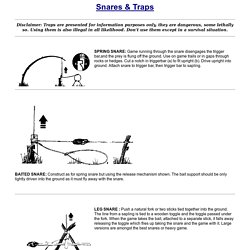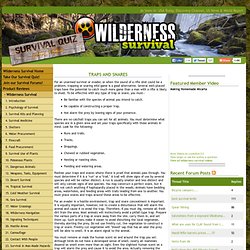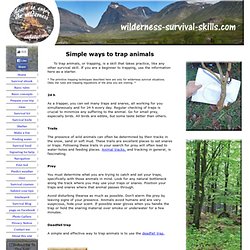

Snares And Traps. Disclaimer: Traps are presented for information purposes only, they are dangerous, some lethally so.

Using them is also illegal in all likelihood. Don't use them except in a survival situation. SPRING SNARE: Game running through the snare disengages the trigger bar,and the prey is flung off the ground. Use on game trails or in gaps through rocks or hedges. Cut a notch in triggerbar (a) to fit upright (b). BAITED SNARE: Construct as for spring snare but using the release mechanism shown. LEG SNARE : Push a natural fork or two sticks tied together into the ground. PLATFORM TRAP: Site over a small depression on the game trail.
FIGURE 4 DEADFALL : A simple and effective deadfall trap, can be made to any size. TRIPWIRE DEADFALL : A heavy log is suspended over a busy game trail, trips the wire and pulls a retaining bar from under two short pegs secured in a tree trunk. BAITED HOLE NOOSE : This trap is very useful for scavengers, drive 4 sharpened sticks into the pit, through the edges. Traps & Snares (PDF) Six Primitive Traps For Catching Food In The Woods. How To Make A Rabbit Snare. When entering a survival situation you will have to work for every meal.

Fats and proteins are essential to provide the energy required to survive brutal Mother Nature. Most inexperienced hunters will struggle to trap a meal in the wild. In this class I will teach you the best way to make a rabbit snare, which may be the deciding factor when facing a sticky situation. The main benefit of trapping your game is that once your traps are set you can focus on other important survival needs such as fire, water, shelter and signaling for rescue. There are dozens of different ways to trap small game whether it’s pit falls, using boulders, deep pits and so on. Free Books: Hide Tanning & Animal Traps.
Snaring A Pig. 4 Ways To Make A Snare Trap. Steps Method 1 of 4: Preparation 1Choose a sturdy noose material, preferably wire.

To build a noose, the most effective material to use is wire.[1] You can use anything as long as it's flexible and not too thin or brittle. It must quickly and easily tighten. There are a number of wire types you can choose from: Craft wireHeadphone wireStripped wires from carsAn uncoiled spring Ad 2If you don't have wire, use string or cord. 5Pick your "engine. " Method 2 of 4: Building a Hook Trigger 1Carve a mouth, or hook, into two sticks. 6Arrange your noose. Method 3 of 4: Building a Three-Stick Trigger 1Hammer down two sticks into the ground. 7Tie a noose underneath the trigger system to the smallest stick.
Method 4 of 4: Building a Fishing Trigger 1Find a sapling near the water's edge. 3Tie one end of your line to the hook and place the baited line in the water. Tips Check your surroundings before you set a snare. Ad Warnings Don't smack yourself with the tree! Food Procurement - Traps & Snares. For an unarmed survivor or evader, or when the sound of a rifle shot could be a problem, trapping or snaring wild game is a good alternative.

Several well-placed traps have the potential to catch much more game than a man with a rifle is likely to shoot. To be effective with any type of trap or snare, you must-- Be familiar with the species of animal you intend to catch. Be capable of constructing a proper trap. Not alarm the prey by leaving signs of your presence. There are no catchall traps you can set for all animals. Runs and trails. Position your traps and snares where there is proof that animals pass through. For an evader in a hostile environment, trap and snare concealment is important. You must remove or mask the human scent on and around the trap you set. Simple Ways To Trap Animals. To trap animals, or trapping, is a skill that takes practice, like any other survival skill.

If you are a beginner to trapping, use the information here as a starter. * The primitive trapping techniques described here are only for wilderness survival situations. Obey the rules and trapping regulations of the area you are visiting.